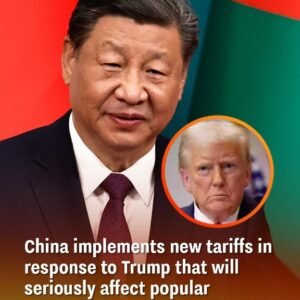In a bold move that highlights rising global trade tensions, China has announced new tariffs in retaliation to actions taken by the United States under President Donald Trump. These tariffs target a wide array of popular U.S. products, potentially increasing costs for American consumers. The decision follows President Trump’s earlier executive orders that imposed tariffs on Chinese imports, which were part of a broader strategy to address concerns about illegal immigration and narcotics.
Shortly after taking office, President Trump introduced tariffs on key trading partners, including China, under the pretext of protecting national security. These tariffs were intended to pressure China to combat issues like the flow of precursor chemicals used by criminal organizations and money laundering. The tariffs began with a 10% levy on Chinese goods, later rising to 20%.
In response, China has implemented its own tariffs on U.S. exports. These include a 15% duty on U.S. coal and liquefied natural gas and a 10% tariff on products like crude oil, farming equipment, and cars. More recently, on March 4, China expanded the list to include U.S.-grown products such as chicken, wheat, corn, and cotton. The rationale behind these tariffs is China’s attempt to protect its industries and retaliate against what it sees as unfair trade practices by the U.S.
These tariffs are likely to significantly affect the U.S. economy, increasing costs for consumers and businesses alike. As China targets key sectors like agriculture and energy, the cost of American products in these industries will rise. For U.S. companies that rely on exports to China, the tariffs represent a considerable challenge, potentially leading to reduced demand and higher production costs. The disruption of trade flows could have a broader impact on U.S. economic growth, possibly contributing to inflation and a decrease in consumer spending.
The broader geopolitical and diplomatic ramifications of the tariffs are also significant. This move further strains U.S.-China relations, which have been tense over issues such as technology transfer and human rights. Both countries are increasingly using tariffs as strategic tools in their economic rivalry, with potential consequences for global stability and trade efficiency. As trade experts note, the escalating dispute could lead to disruptions in global supply chains, affecting markets far beyond the U.S. and China.
The tariffs have sparked polarized reactions, with some U.S. policymakers expressing concern over the long-term economic impact, while others support the measures as necessary to protect domestic industries. The situation has also led to calls for multilateral dialogue and a more cooperative approach to resolving trade disputes. A comprehensive trade agreement, experts suggest, would help address the underlying issues and prevent further escalation, but such an agreement remains challenging given the complex nature of U.S.-China relations.
Ultimately, the escalating tariff dispute underscores the interconnected nature of global trade and the need for careful diplomacy. The path forward will require both countries to balance national interests with the broader goal of global stability. The decisions made in the coming months will have lasting effects on international trade relations and the economic landscape worldwide.
